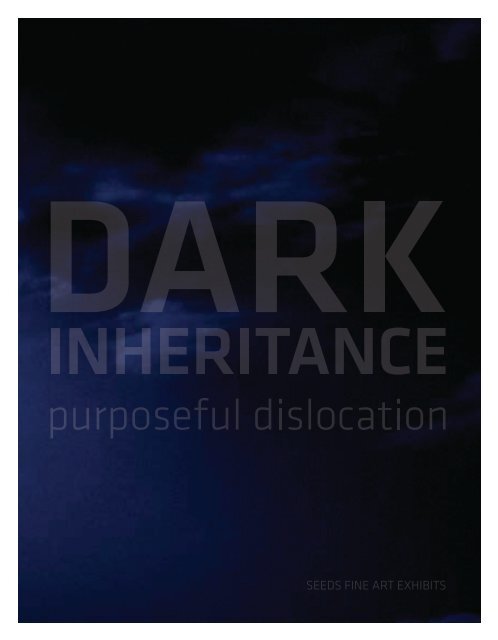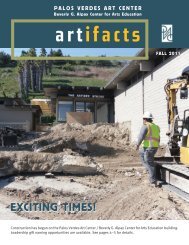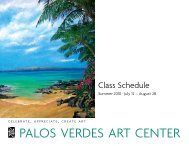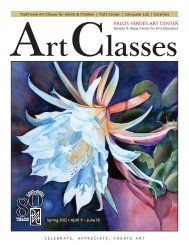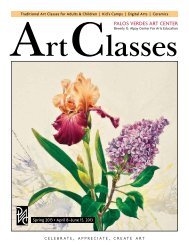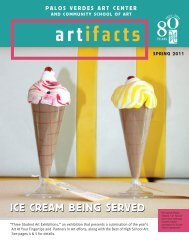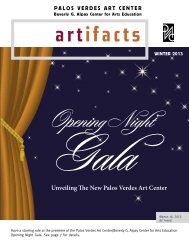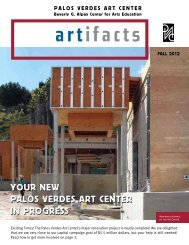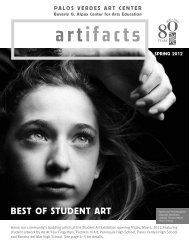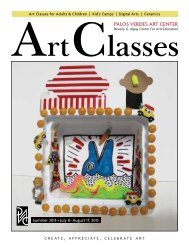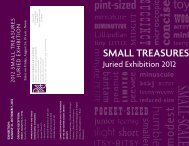SEEDS FINE ART ExHIBITS - Palos Verdes Art Center
SEEDS FINE ART ExHIBITS - Palos Verdes Art Center
SEEDS FINE ART ExHIBITS - Palos Verdes Art Center
Create successful ePaper yourself
Turn your PDF publications into a flip-book with our unique Google optimized e-Paper software.
Seeds Fine <strong>Art</strong> Exhibits
BIOLA University<br />
August 21, 2010–September 30, 2010<br />
<strong>Palos</strong> <strong>Verdes</strong> <strong>Art</strong> <strong>Center</strong><br />
October 29, 2010– January 8, 2011<br />
curated by Cindi Zech Rhodes & Denise Kufus Weyhrich
Table of contents<br />
3 Forward<br />
4 Essay by Barry Krammes<br />
9 <strong>Art</strong>works<br />
9 Dualities<br />
Vinita Voogd, Collected Stories<br />
Marianne Lettieri, Naming Day and Mantel of Iniquities<br />
Bo Choi, Power and Powerless<br />
11 The Enemy Within<br />
Regina Jacobson, Fear<br />
Mark Cummings, Save Me from Myself<br />
Christopher Scardino, Prophet<br />
Andrew Myers, Recycled Tears<br />
12 Brother Against Brother<br />
Simon Kogan, Cain and Abel and Jealousy<br />
Grace Carol Bomer, Eli, Eli, lama sabachthani (My God, my God, why have you forsaken me)<br />
Duncan Simcoe, 2 Boys and a Sword<br />
14 Change<br />
Guy Kinnear, Pater Noster: Blind Paul<br />
Wayne Forte, Self-portrait with Changed Mouth<br />
Janice Lowry, Learning to Fly<br />
LeRoy Schmaltz, Seeing Through the Heart of Things<br />
16 Healing<br />
Jeff Lefever, Meditation in Black and White: Life, a Reflection<br />
Lynn Aldrich, Seeking Sanctuary<br />
Denise Weyhrich, Tabernacle<br />
17 Life’s Journey<br />
Marsha Brady, A Contemplation Upon Flowers<br />
Larry Brady, Psalm 102:15<br />
Anne England, Life Tower<br />
Tom Lamb, Marks of the Land—Irvine<br />
Craig Goodworth, Triduum<br />
William Catling, Gently and Slowly Rising<br />
20 Acknowledgements<br />
Forward<br />
Cindi Zech Rhodes <strong>SEEDS</strong> Fine <strong>Art</strong> Exhibits curator<br />
“In the darkness of this void, this seemingly endless black of trials, there is the barest smell of water. Though the deep is not<br />
navigable on my own, the corner of my eye catches a shuttered flash of light, drawing me like Aslan beckons “further in, further<br />
up”. My ear catches the quietest of whispers—come hither beloved, come hither.”<br />
—CZR<br />
Dark Inheritance—purposeful dislocation came about as a slow, long gestation and birth. During the last eight years,<br />
Denise and I along with a myriad of gifted fine artists, have explored many facets of our relationship with God. We have visited<br />
the ideas of God revealed through different cultures. We have celebrated the newness of life expressed through the blessing<br />
and sacredness of children and nature. We have explored the names of God and traveled the road from The Last Supper to<br />
Easter morning. We have focused on our vital need for each other, for friendship, support and help. And finally, we’ve come<br />
back to the garden. To that willful independent yank of the apple from the tree of the knowledge of good and evil, which divides<br />
us from the Divine.<br />
It is this darkness, this inheritance, this compulsion to rush and touch the beautiful flame, which makes us human.<br />
But also present at the same time, is the bright spark of the breath of God in us. We recognize it in each other in times of<br />
transparency and transcendence. The psychiatrist Carl Jung tells of our “shadow sides” without which we cannot truly have a<br />
full reflection ourselves, with potentials for both good and evil. It is the diametrical pull that turns our head and hearts back to<br />
God, where our comfort is expressed by the Old Testament psalmist, reminding us, that we are not alone.<br />
“Even the darkness is not dark to You, And the night is as bright as the day. Darkness and light are alike to You.”<br />
Psalm 139:12 (NASB)<br />
Denise Kufus Weyhrich <strong>SEEDS</strong> Fine <strong>Art</strong> Exhibits curator<br />
“There is a tide in the affairs of men, which taken at the flood, leads on to fortune. Omitted, all the voyage of their life is bound in<br />
shallows and in miseries. On such a full sea are we now afloat. And we must take the current when it serves, or lose our ventures.”<br />
— Brutus (in Shakespeare’s Julius Caesar)<br />
The crossroads of our lives are too often not revealed, as Shakespeare observes and we see Brutus and his conspirators<br />
lead to their own destruction. A few years back, Cindi and I experienced two exhibits “100 <strong>Art</strong>ists See Satan” and “100 <strong>Art</strong>ists See<br />
God.” These exhibits set us on a path to attempt to address the subject of Dark Inheritance—purposeful dislocation. The flippant<br />
devil-may-care attitude of these exhibits along with the questioning of the existence of a loving God in our cruel world truly lodged<br />
in our minds. So, the challenge of developing a thoughtful multifaceted response was simply a matter of time as one by one the<br />
artworks were gathered.<br />
What you hold in your hand is the product of our lives—of strange dichotomies: blessing or curses, triumphs or wounds,<br />
floating adrift or taking the current, and waging wars or surrendering to trust and love. The saying “That which I would not, that<br />
do I do” is ever present in both the large and small actions of life. My old habits die hard despite my best intentions. I need wiser<br />
guidance. Ultimately, I realize that I am not in control of the bigger challenges of life and death. But by having a correct diagnosis,<br />
the solution is clearer. In finding out the details of my own health condition, I have come to realize how my numbness can lead to<br />
great damage, one tiny misstep can result in a grave consequences, and I constantly need to monitor myself or disaster results.<br />
My need to be conscious of this tenuous balance has led me to be more reliant on Christ.<br />
3
The exhibition includes 23 artists and 70 works of art utilizing a wide range of materials including drawing, painting,<br />
photography, sculpture, printmaking, video, calligraphy, assemblage, fabric constructions and installation. Most of the work<br />
in this show is narrative. Discovering artists’ stories and learning to see from their unique point of view helps us understand<br />
nuances of thoughts and ideas we might never otherwise encounter. Six sub-themes: Dualities, The Enemy Within, Brother<br />
Against Brother, Change, Healing and Life’s Journey help direct the viewer throughout the exhibition.<br />
Dark Inheritance:<br />
Purposeful Dislocation<br />
by Barry Krammes<br />
Man is a creature who walks in two worlds and traces upon the walls of his cave the wonders and the nightmare<br />
experiences of his spiritual pilgrimage.—Morris West, The Clowns of God<br />
I was acquainted with a churchman who for years conscientiously directed the choir and served on the board of elders<br />
in his local congregation. One night, in a moment of uncontrollable anger, he accidentally strangled his beloved wife. Homo<br />
sapiens are complex, self-centered creatures capable of the most heinous atrocities as well as the greatest humanitarian<br />
deeds. Within each one of us lurks potential for both good and ill. A Cherokee legend describes two wolves within, one white,<br />
the other black, vying for control. Saint Augustine referred to this interior struggle between good and evil as a “house divided<br />
against itself.” And we are all too familiar with the image of a protagonist with both a devil and an angel perched on his<br />
shoulders, aggressively whispering encouragements from both directions simultaneously.<br />
The artwork in Dark Inheritance is not meant primarily to pleasure or entertain the viewer, but rather to force the<br />
observer to look within and focus on his/her own interior state. Max Benavidez suggests, “At their best, the arts are about<br />
looking deeply into dark places.” It is easy to recall the riveting political prints of Hogarth and Daumier; Goya’s convulsively acidic<br />
Disasters of War, and the angst-ridden work of the German Expressionists on the brink of World War II.<br />
In our own time, we think of artists such as Andreas Serrano, Cindy Sherman, Joel-Peter Witkin and Paul McCarthy who<br />
convincingly reveal the darkest and bleakest scenarios with bravado-like gusto. Some of the current generation of painters—Jenny<br />
Saville and Cecily Brown for example—grab their viewers “by the throats,” demanding contemplation of the most over-the-top hard<br />
to look at images, images that have the power to “shock your socks off.” In fact, some of the new object makers, fashioning found<br />
and fabricated materials into gritty, in-your-face sculptures, refer to their pieces as “guttural upchucks.”<br />
I tend to be suspicious of artists who employ gratuitous shock in their art. It cheapens the work. I’m also wary of<br />
artists who use art merely as a tool to propagate their various agendas and ideologies. Yet, standing before the dark art<br />
created by the hands of a skilled artist can be a profound visual experience. Viewing Picasso’s Guernica in Madrid’s Reina Sophia<br />
Museum was an insightful, transforming moment for me. In meditating on man’s inhumanity to man and viewing atrocities<br />
perpetrated on the innocent, my breath was taken away. In silence I inwardly wept for both perpetrators and victims of the<br />
conflicts and wars that continually plague our planet.<br />
While much current art practice is conceptual in nature—concerning itself with clever games and philosophical puzzles—<br />
the art in this exhibition is of a distinctly different variety. The curators of Dark Inheritance selected the artists and their work<br />
specifically because of its spiritual nature, that is, work purposefully exploring the paradoxical, ambiguous, baffling character<br />
of human existence. Although some in the art community do not agree that art can have a spiritual dimension, almost<br />
everyone would acknowledge the validity of an instrumentalist approach to art making that examines life’s complexities and<br />
conundrums from varying perspectives.<br />
Dualities<br />
An appropriate place to begin is with the sub-theme of dualities and India born artist, Vinita Voogd. One of her<br />
pieces, a fabric construction called Collected Stories, patches together a lush tapestry of intricate fragments from a wide<br />
variety of sources. Relying on the intense colors of India, her richly woven wall hanging with fishhooks and lures speaks of the<br />
intersections between East and West, her native homeland and her new life in Southern California. Gathering both stories and<br />
materials, she creates a sensuous visual feast exploring, in her own words, “dualities of wealth and poverty, peace and discord,<br />
technology and ecology in a universal landscape of harmony.”<br />
Marianne Lettieri also uses fabric to reveal the dualities of good and evil. Naming Day—Animals of the Ark is an<br />
all-white christening gown covered with a myriad of creatures from land and sea. Its pristine crispness speaks of beginnings,<br />
of innocence and of a beautiful world devoid of evil. The purity of Naming Day is in stark contrast to Mantel of Iniquities, a<br />
cadmium red Geisha-like robe festooned with objects that hint at a life filled with sin. By pairing the two garments, Lettieri<br />
seems to suggest that all too soon the blamelessness and naïveté of early childhood gives way to the dubious experimentation<br />
of youth, corrupted by a freewheeling, jaded society with few restraints or admonitions.<br />
In her works with fabric, Bo Choi, a Korean-American artist, first cuts, then reconstructs garments into what she<br />
refers to as Second Skins. In addition, she makes photographs, videos and installations often with this reconfigured clothing.<br />
Power and Powerless, her hauntingly beautiful, multiple layered photo images of animated white dress shirts, conjure up a<br />
number of dualities. In one photograph, a floating shirt with many sleeves raises its left hand in a commanding gesture while<br />
the right seems to passively protrude from a gigantic cuff. Associations with orating politicians, dictators or preachers make the<br />
viewer conscious of those in control and by default, those who have no voice—leader/follower, dominant/subordinate, insider/<br />
outsider, elite/ordinary, employer/employee, authority/novice.<br />
The Enemy Within<br />
The Enemy Within, a second sub-theme, looks at work in the exhibition related to the interior battle we all wage.<br />
In Save Me From Myself, Mark Cummings paints an unforgettable image of conflict. With a sacred heart throbbing in the<br />
background, the hand of God pulls a desperate young man from the shell of his shackled self. Cummings, who refers to himself<br />
as a “classic artist,” employs all the tricks of a melodramatic Hollywood illustrator to make his point clear. Stylized graphic<br />
qualities and facile brushwork gives one the feeling that this is a poster for some B-rated religious movie. With its kitsch<br />
sensibilities, the artist has delivered his message in no uncertain terms: sometimes we are our own worst enemies.<br />
Regina Jacobson, another figurative painter working in the realist tradition, depicts Fear in the guise of a pubescent<br />
girl. We recall a host of artists, both past and present, whose riveting, psychological portraits of vulnerable young women<br />
(Edvard Munch, Eric Fischl, Helen van Meene) never fail to succeed in packing a walloping punch. Somehow all of us, male or<br />
female, can wholly relate to that most awkward, painful, tortured time of life, when alone and paralyzed by fear we confronted<br />
the fact that regardless of whether or not we were ready for change, it would come nonetheless. Puberty is suggestive of<br />
change and change with its sidekick fear, reappears over and over again in the cycle of life.<br />
Scardino’s Prophet is for me one of the most fear-producing images in Dark Inheritance. History tells us of genuine<br />
prophets as well as false ones. Many who claim to be the real deal, aren’t. Is the seer in Christopher Scardino’s painting warning<br />
of cataclysmic events to come or amassing power, trying to con the gullible and easy to fleece His ambiguous form stirs a<br />
sense of bafflement, that awful feeling of uncertainty with which we struggle on a regular basis. The inverted, upside down,<br />
surreal nature of much in life often makes it difficult to discern the authentic from the knock off. We’re left with the unsettling<br />
feeling that we’ve been duped when what we long for is authenticity.<br />
Andrew Myers’ bronze sculptures are playful compared to the other works of art in this section. At first they<br />
seem to be one-liners but then they wriggle their way into the “museum of my mind” and are probably there to stay. I keep<br />
4<br />
5
thinking about Recycled Tears. We recycle to save the earth, but why tears Because they’re a precious commodity to some.<br />
For individuals who “stuff” their emotions and never deal with them, recycling might be the best alternative. Healthy people<br />
manage to work through the negative feelings that come their way, but for those who have been conditioned and shamed into<br />
thinking that they can never cry, Myers might very well have the solution.<br />
Brother Against Brother<br />
The third sub-theme deals with the age-old conflict of domestic violence and sibling rivalry. Russian artist Simon<br />
Kogan depicts these themes in his intimate, Rodin-inspired bronzes. Old Testament literature is filled with stories of fighting<br />
brothers vying for a blessing: Cain and Abel, Ishmael and Issac, Jacob and Esau, Joseph and his brothers. What causes a man to<br />
be so consumed with rage that he takes the life of the one who is most like him (A study from New York University’s School<br />
of Medicine recently reported that Palestinians and Jews have similar DNA.) It seems we are often most hostile to the people<br />
closest to us. With all the expressionistic huptzpah Kogan can muster, he dishes up Jealousy as a writhing, seething piece of<br />
headless flesh bent not only on his brother’s destruction, but on his own as well.<br />
Of all the genocides committed against an endless roster of people groups throughout history, none have captured<br />
the imagination of the American people more than the Holocaust. Dozens of movies, books and works of art have been devoted<br />
to this massacre. The words “Never Forget” or “Never Again” have been etched into our psyche. Grace Carol Bomer, meditating<br />
on the plight of those who suffer, paints Eli, Eli, lama sabachthani (My God, my God, why have you forsaken me), a scene of<br />
nightmarish proportions. In it, a contorted figure in fetal position screams into the dark abyss, terrified of the seen and unseen,<br />
reduced to a frenzied soul in the depths of despair. We are reminded of Holocaust Jews, hidden away in unimaginable nooks and<br />
crannies desperately fighting for their very lives. On their lips was the prayer of the ancient psalmist (Psalm 22), and of Christ on<br />
the cross, “My God, my God, why have you forsaken me” One Holocaust survivor said, “I stopped praying and believing in God<br />
as I watched my mother being pushed to her death in the gas chambers.”<br />
Duncan Simcoe’s elegant linear drawings on tarpaper reference the contemporary rivalry between Palestine and Israel.<br />
His Ishmael Series is a longstanding exploration of insider/outsider relationships. Over the years Simcoe’s Ishmael character<br />
has been a stand-in for other disenfranchised groups and individuals, including the artist himself. The series contains a wide<br />
range of scenarios involving two male figures (often adolescent) performing various actions in modern suburban settings. By<br />
making his narratives universal as well as personal, Simcoe’s drawings take on a convincing validity. 2 Boys and a Sword appears<br />
as a candid snapshot but with the ever present, aura encompassed weapon hovering above, a continual reminder of the violent<br />
nature of daily life in many parts of the world today.<br />
Change<br />
Can life-long habits, beliefs and behaviors be altered The fourth sub-theme looks at ways artists think about change.<br />
The dramatic story of Saint Paul’s conversion in the New Testament is a compelling example of transformation. Guy Kinnear’s<br />
Pater Noster: Blind Paul, depicts the zealous persecutor of fellow Jews, leveled by God to a state of complete vulnerability. Blinded,<br />
naked and in the dirt, the once proud Paul is left to grovel. It seems that change often happens as the result of traumatic events<br />
outside our control such as death, divorce, disaster, devastating illness or a divine encounter with God. Kinnear’s painting is<br />
powerful because he shows us that luminal moment when Saul becomes Paul, when old is replaced by new, when hatred and<br />
murder become love. The title of the painting, Pater Noster or Lord’s Prayer, references a request for God to “deliver us from evil.”<br />
But Saint Paul was never perfect. Although change was forced upon him, he continued to fight his demons. “For the<br />
good that I will to do, I do not do; but the evil I will not to do, that I practice.” It sounds all too familiar doesn’t it Philipino-<br />
American artist Wayne Forte gives us a piercing self-analyzing portrait dealing with this struggle. He calls it Self-portrait with<br />
Changed Mouth. Drawing attention to the mouth by putting a rectangle around it, he makes it the focal point of his powerful<br />
linear composition. Forte was no doubt thinking of another New Testament passage from the book of James: “The tongue is a<br />
fire that no man can tame. It is an unruly evil, full of deadly poison. Out of the same mouth proceed blessing and cursing.” Forte<br />
reminds the viewer that what comes out of our mouths continually gets us into trouble. Anyone in control of the tongue, James<br />
tells us, can “bridle their whole body.” A changed mouth may be indicative of substantive interior change.<br />
One day, years ago, I ran into artist Janice Lowry. “How are you doing” I innocently asked. “Well,” she replied, “I’ve<br />
stopped making art.” I wanted to know why. “I’ve finally left an abusive relationship and now there’s nothing to make art<br />
about.” At the time, Janice was in the throws of change. Eventually, her difficult childhood and troubled early years were<br />
replaced with healthy relationships and a positive, prolific artistic practice. Her assemblage, Learning To Fly, was one of the last<br />
pieces Janice completed just a few months prior to succumbing to cancer in September 2009. A porcelain doll holding a bird<br />
head has been hurled from a distant nest. It feels like she is falling to her demise, however the feather in the corner is a hopeful<br />
sign, indicating not a tragic outcome but a possible flapping and thrashing at the last moment to ascend to the heavens.<br />
Although this piece is painful to look at, we intuitively understand that the artist has been given wings and taken flight, forever<br />
freed from the shackles of this life.<br />
Like Janice Lowry, Leroy Schmaltz has been assembling found objects for years. Taking the detritus of our “throw it<br />
out” society, he reclaims fragments from multiple sources to create sculptures. Seeing Through the Heart of Things speaks of<br />
trying to gain perspective, peering through the jumble of life. Unifying the composition with repeated circles of various sizes,<br />
Schmaltz alludes to articles used to accentuate vision: glasses, monocles, peepholes, scopes of various kinds, all intended<br />
to give us clearer insight and thereby more accurate perception. Before effective change can take place, problems must be<br />
identified and the heart of the matter must be determined.<br />
Healing<br />
The fifth sub-theme deals with the possibility of more permanent change—healing. Photographer Jeff LeFever<br />
travels the globe capturing sacred spaces in world-class cities. His photographic essay video, Meditation in Black and White:<br />
Life, a Reflection, documents interiors of sacred spaces and contrasts them with images shot on the surrounding city streets.<br />
The photographs in his slide show were taken in the Czech Republic and the beaches of Laguna Beach California. From the<br />
gothic, St. Vitas Cathedral, to Europe’s oldest surviving medieval synagogue, Prague is a magical place where one can easily be<br />
transported back in time. Medieval sacred spaces were created to function as a diversion to the exterior world outside, helping<br />
the worshiper focus on the spiritual realm. LeFever’s inside/outside approach pits the harshness of life on the street against<br />
the therapeutic, otherworldliness of the holy.<br />
The medieval cathedral was not only a consecrated area but a safe location as well. “Sanctuary” was a term used<br />
in the Middle Ages to describe a house of worship as a place that provided the right to asylum. Hunted individuals could not<br />
be prosecuted as long as they remained within church confines. “The New Sanctuary Movement,” begun in the ‘80s, provides<br />
places of safety for refugees and undocumented laborers threatened with exportation. Lynn Aldrich’s Seeking Sanctuary, a<br />
large-scale sculpture made of corrugated plastic sheeting from Home Depot, references this “safe haven” idea. By simply<br />
cutting and layering corrugated plastic in the shape of an arch, Aldrich creates a striking spiritual metaphor imbued with<br />
pensive possibilities.<br />
“Hospital” is another descriptor used for places of worship, centers where the bruised and wounded, sick and<br />
suffering come for help. Co-curator and installation artist Denise Weyhrich wants us to think about healing. Her piece brings<br />
us into the intimacy of Christian adoration. Collecting over 70,000 plastic, disposable communion cups from her congregation<br />
in Orange, she arranged and assembled these tiny, clear, wine stained containers in a circular formation resembling a gigantic<br />
cup. Christianity is a religion that functions best as a corporate, community-based organism. The Eucharist, the central part of<br />
Christian worship, is a “family” meal recounting the death and resurrection of Christ. Weyhrich’s Tabernacle implies that healing<br />
occurs as a result of God’s presence filling individuals, groups and organizations, both professional and laymen, as they join<br />
together in a concentrated effort of restoration.<br />
Life’s Journey<br />
The last sub-theme grapples with the journey of life we are all on. Six artists express their philosophies in this part of the<br />
exhibition. The first are Marsha and Larry Brady, master calligraphers. A Contemplation Upon Flowers is their violet and cadmium<br />
yellow floral composition based on a poem by Henry King, Bishop of Chichester (1592–1669), and friend of British poet, John Donne.<br />
Pansy-like, invented flowers fill the picture plane with pistils and stamens in an intoxicating swirl of marks and colors. This riotous<br />
arrangement so “fresh and spruce” reflects the verve of life’s full embrace. But we know what happens next. King reminds us of<br />
the futility of striving for eternal spring. Fresh flowers always affirm life, but all too soon wither and perish. Like the lilies of the<br />
field, we’re here one day and gone the next. Pulling dead flowers from a vase of stale water is a pungent reminder of the brevity of<br />
life. King beseeches the flowers, oblivious of their approaching doom, “Teach me to see Death and not to fear.”<br />
6<br />
7
Anne England has learned to accept life’s uncertainties. Life Tower is a quirky little monoprint that says a lot about<br />
journeying. One of the grand dame’s of Southern California printmaking, England always has a little hope in her art. Besieged<br />
by cancer for years, England is a survivor. “Honey,” she says, “I’ve had so many different kinds of cancer, I only have one of<br />
everything left.” Such a humorous, grace filled attitude, marks the life of someone who has learned to take what time bestows<br />
and deal with it. In her work, threatening clouds and a menacing black bird overshadow a dumpy, imperfect, even crumbling<br />
tower. The dark upper portion of the composition skillfully plays against the intricate detail found in the bright red structure.<br />
However, it is the larking about, expressive qualities of the piece that make it so endearing.<br />
Perspective or point of view is everything to the artist. Photographer Tom Lamb shoots his images from helicopters.<br />
Aerial, bird’s-eye perspectives breathe life into his prints. From below, his scenes are mostly unnoticed bits of fairly mundane<br />
landscape, but from the air beautiful patterns and textures emerge filling his compositions with a compelling presence. Marks<br />
on the Land —Tustin photographs shows the landing pad of a runway with a crossed out #1, a serendipitous reminder that we<br />
should always maintain a sane estimation of ourselves. The formal abstract qualities of his work contrast with a light hearted<br />
entropy, causing mesmerizing results. It’s sometimes difficult to evaluate the circumstances of our daily existence since we’re<br />
all in the thick of it, too close to see things objectively. Examining from multiple viewpoints, stepping outside our particular<br />
situation to glimpse a heavenly view, seeing as it were with new eyes, these approaches are essential in this journey of<br />
unfolding discovery.<br />
While Tom Lamb has his head in the clouds, Craig Goodworth’s art is mired to the earth. Taking some of his cues from<br />
Joseph Bueys, Goodworth refers to himself as an artist/pilgrim. Performing actions and creating ritualistic events, he explores<br />
and scavenges the natural world, finding carcasses, mammal skulls, and other dead remnants readily available in the environs<br />
of the Southwest. Seeing Triduum, Goodworth’s video synopsis of a prayerful, three-day event, the viewer is immediately<br />
conscious of the brutal realities of the animal kingdom and the grinding struggle for survival. Finding a dried up deer carcass in<br />
the desert, Goodworth purposefully desecrates it by puncturing the hide with long steel rods. On the third day of the ritual he<br />
jerks the rods back out of the mangled remains with measured intention. The resulting magnificent pattern of light floods the<br />
bullet-like holes, illuminating the dark interior. Watching these moving images, one is aware that somehow out of death new<br />
life emerges and continues to flourish unabated.<br />
Bill Catling, Goodworth’s mentor, also uses natural materials (clay and branches) and reflects a timeless, archaic<br />
sensibility through his work. The Golem-like figures Catling pulls from the earth are lacerated, scarred and shrouded with<br />
an eerie, victimized stillness. In Gently and Slowly Rising, we feel the sluggish upward thrust of an exhausted female nude<br />
almost as if she has just exhaled for the last time. Wings made of steel and wire suggest that ascendancy is imminent and “an<br />
expansive journey” is about to take place – a journey into the eternal realm. Catling’s art affirms a deep connection to a mythic<br />
past and to the bodily roots of this world. His tortured creations represent the pain, degradation and suffering of this physical<br />
life but also the possibility for transformation of darkness into a positive, redemptive force.<br />
Vinita Voogd<br />
Collected Stories<br />
2010<br />
collagraph, chine collé,<br />
collage and assemblage<br />
mounted on birch<br />
62 x 16 in.<br />
DUALITIES<br />
8<br />
Conclusion<br />
The power of art lies in its ability to let us get inside the deepest part of another human being, in a place beyond<br />
words and the rational, where anything is possible. In Dark Inheritance, the stories of 23 artists have been juxtaposed in a visual<br />
panoply of processes, concepts and expressions. Being invited to look into their worlds has given us specific examples of the<br />
human struggle and what it means to be mortal. This show explores the reality of evil as a major part of the human condition<br />
and the flawed nature of being finite. That good often resides with the bad; that our heavens and hells are often “inches apart”;<br />
that our “wonders and nightmares” often collide; that a moment of emancipation is often followed by an act of devastation—<br />
these are the conundrums impossible to reconcile, to understand or make sense of.<br />
Eventually we must “lay it all down” and acknowledge that life is paradoxical and ultimately a mystery. While theology<br />
and the sciences tend to solve problems that provide answers, the arts work best when they ask the challenging questions<br />
of life and abide beyond the realm of human understanding. The artists in this exhibition, grappling with these challenging<br />
psychological and spiritual complexities, have created works resulting in prophetic critiques, honest confessions and redemptive<br />
fragments. To use the words of theologian Wilson Yates, they have given us “The facts of our mortality, our caughtness, our<br />
passion as unequivocal parts of our lives, but at the same time have pulled us into a recognition that we know and do not know<br />
what they finally mean.”<br />
Marianne Lettieri<br />
Naming Day<br />
2009<br />
assemblage<br />
36 x 15 x 8 in.<br />
Marianne Lettieri<br />
Mantle of Iniquity<br />
2009<br />
assemblage<br />
60 x 53 x 2 in.
Bo Choi<br />
Second Skin—Power and Powerless<br />
2009<br />
white dress shirts<br />
60 x 6 x 26 in.<br />
Regina Jacobson<br />
Fear<br />
2009<br />
oil on canvas<br />
16 x 16 in.<br />
Mark Cummings<br />
Save Me from Myself<br />
2009<br />
oil on canvas<br />
48 x 24 x 3 in.<br />
THE ENEMY WITHIN<br />
Christopher Scardino<br />
The Prophet<br />
2009<br />
acrylic/oil on panel<br />
54 x 2 x 36 in.<br />
11
Andrew Myers<br />
Recycling Tears<br />
2008<br />
bronze zebra wood cement<br />
18 x 13 x 24 in.<br />
Grace Carol Bomer<br />
Eli, Eli, lama sabachthani<br />
(My God, my God, why have<br />
you forsaken me)<br />
1995<br />
mixed media on canvas<br />
52 x 40 x 2 in.<br />
Duncan Simcoe<br />
2 Boys and a Sword<br />
2002<br />
alkyd on tar paper<br />
40 x 32 in.<br />
Simon Kogan<br />
Cain and Abel<br />
1990<br />
bronze edition of 9<br />
10.5 x 6 x 4 in.<br />
Simon Kogan<br />
Jealousy<br />
1992<br />
bronze edition of 9<br />
7 in.<br />
BROTHER AGAINST BROTHER<br />
13
CHANGE<br />
Guy Kinnear<br />
Pater Noster: Blind Paul<br />
2010<br />
oil on panel<br />
24 x 16 in.<br />
Wayne Forte<br />
Self-portrait with Changed Mouth<br />
2002<br />
charcoal on rag paper<br />
50 x 40 in.<br />
Janice Lowry<br />
Learning to Fly<br />
Bush Street Studio<br />
March 2009<br />
assemblage<br />
18.5 x 11.75 x 4 in.<br />
LeRoy Schmaltz<br />
Seeing Through the<br />
Heart of Things<br />
2010<br />
wood and found objects<br />
26 x 19 in.a<br />
14<br />
15
HEALING<br />
Denise Weyhrich<br />
Tabernacle (Detail)<br />
2010<br />
communion cups, ribbon<br />
60 x 52 x 52 in.<br />
Jeff Lefever<br />
Meditation in Black and White: Life, a Reflection<br />
2009<br />
photographic essay video<br />
Lynn Aldrich<br />
Seeking Sanctuary<br />
2005<br />
corrugated plastic and fiberglass<br />
panels, aluminum rivets<br />
55 x 19 x 56 in.<br />
Marsha Brady<br />
Contemplation Upon Flowers<br />
2010<br />
gouache and watercolor<br />
25.75 x 22.5 x 1 in.<br />
Lawrence Brady<br />
Psalm 102:15<br />
2008<br />
ink and stamping on watercolor paper<br />
24.75 x 24 x 1 in.<br />
LIFE’S JOURNEY<br />
16
Anne England<br />
Life Tower<br />
2007<br />
monoprint<br />
16 x 25.5 in.<br />
Tom Lamb<br />
Marks of the Land—Tustin<br />
2006/2010<br />
photography<br />
44 x 56 in.<br />
Craig Goodworth<br />
Triduum<br />
2009<br />
video and installation<br />
William Catling<br />
Gently and slowly rising<br />
2001<br />
Ceramic, steel and wire<br />
60 x 53 x 8 in.<br />
18
20<br />
CURATORIAL ACKNOWLEDGMENTS<br />
To produce an exhibit such as this during a time of crisis seemed to make sense. Though the way was circuitous<br />
and challenging, one by one our dream opportunities were given. We thank our families for their great part in this long<br />
venture, not only for emotional and financial support, but also for practical help with technology, building, and muscle. In the<br />
development of this exhibit and catalogue Barry Krammes remained a constant encouragement and a beacon. His essay<br />
is priceless, and an encouragement to all artists to be real and to continue to risk their hearts. For years, the artists have been<br />
encouraging us to provide a catalogue. This permanent printed record of this exhibit would not be possible, or so beautiful,<br />
without the extremely generous Vesna Petrovic and her graphic design studio Picnic Design.<br />
Looking at these amazing artworks, the presence of each artist and their life’s struggle is shared. We, as curators,<br />
are privileged as we were invited into their narrative, their studios and homes, to search out the art for this exhibit. Their<br />
trust and friendship mean the world to us as they openly offer their gifts and hearts in this exhibit. The timing for many<br />
artists was extremely difficult, as they faced death, sickness, and great loss in their lives and each piece provides a significant<br />
contribution to the collective whole. They graciously received our late night phone calls, e-forms, endless emails and their<br />
participation is invaluable.<br />
Not only have these two institutions, BIOLA University and <strong>Palos</strong> <strong>Verdes</strong> <strong>Art</strong> <strong>Center</strong> , given us these incredible exhibit<br />
spaces and the opportunity to exhibit, they have also provided the funding for this catalogue. BIOLA has been both a cornerstone<br />
for the fine arts dealing with works of faith and the issues of our world. <strong>Palos</strong> <strong>Verdes</strong> <strong>Art</strong> <strong>Center</strong> has been a target for us not only<br />
as Denise’s hometown, but also as a highly respected beacon of culture in LA County. These venues would not have been possible<br />
without the vision and support of the gallery directors, Barry Krammes and Scott Canty.<br />
Finally, Thanks to the kindness, support and prayers of our friends, our home church of St. John’s Lutheran in Orange<br />
CA and by the grace of God, <strong>SEEDS</strong> will continue to grow. Thank you all so very much, Cindi & Denise.<br />
Scott Canty Director of Exhibitions<br />
The <strong>Palos</strong> <strong>Verdes</strong> <strong>Art</strong> <strong>Center</strong> is nestled on the corner of Crenshaw Boulevard and Crestridge Road in Rancho <strong>Palos</strong><br />
<strong>Verdes</strong> where prominent places of worship intersect the center; Saint John Fisher Catholic Church, Peninsula Community Church,<br />
Congregation Ner Tamid of South Bay and Church of Jesus Christ of Latter-Day Saints Luanda Bay Ward. The <strong>Palos</strong> <strong>Verdes</strong><br />
Peninsula is home to many places of worship throughout the community, including Wayfarer’s Chapel—The chapel’s architect,<br />
Lloyd Wright, son of the pioneering American architect Frank Lloyd Wright, designed the chapel to interconnect nature and<br />
architecture—both are united to celebrate the presence of God.<br />
Early this year Denise Kufus Weyhrich and Cindi Zech Rhodes approached the center about an idea for an exhibition;<br />
DARK INHERITANCE—PURPOSEFUL DISLOCATION. This conceptual exhibit includes artworks from 23 artists, both national and<br />
international artists sharing their views and insights on issues of a spiritual matter. Considering our location, I decided to accepted<br />
this idea and bring an exhibition that touches on the spiritual in art to our community.<br />
The exhibition program would like to thank the <strong>Palos</strong> <strong>Verdes</strong> <strong>Art</strong> <strong>Center</strong> Board of Trustees, art center volunteers, the<br />
exhibitions committee and the dedicated staff for their continued vision and commitment to the arts in Southern California. In<br />
addition, our guest curators, Cindi Zech Rhodes and Denise Kufus Weyhrich, and BIOLA University Professor/Gallery Director, Barry<br />
Krammes for including the art center in this partnership. This exhibition is sponsored, in part, by the Los Angeles County Board of<br />
Supervisors, through the Los Angeles County <strong>Art</strong> Commission.<br />
Barry Krammes Professor<br />
Biola University is pleased to welcome Cindi Rhodes, Denise Weyhrich and the <strong>SEEDS</strong> artists to the Biola University <strong>Art</strong><br />
Gallery. It is also a pleasure to partner with Scott Canty and the good folk at the <strong>Palos</strong> <strong>Verdes</strong> <strong>Art</strong> <strong>Center</strong>. I met Cindi and Denise a<br />
number of years ago and have become a fan of their annual <strong>SEEDS</strong> exhibition, which brings together a wide variety of visual artists<br />
exploring a diversity of substantive issues related to spirituality. Attending a College <strong>Art</strong> Association Conference several years ago,<br />
I distinctly remember an art critic suggesting that there were just two categories of art: one was decorative and the other spiritual.<br />
That idea made sense to me and since then I have endeavored to discover spiritual qualities in all artwork.<br />
Scholarship reveals that in periods of great transition and change, like those currently confronting our nation and<br />
the world, artists naturally gravitate toward dark imagery. Dark Inheritance is a timely and challenging exhibition, one that invites<br />
the viewer to reflectively ponder the disturbing complexities of the human condition. Looking and seeing are two distinctly different<br />
activities. Having an authentic encounter with a work of art can be a moment of significant awakening. Hundreds of hours have<br />
been accumulated putting together this exhibition, all with the hope that many who come to look—will take time to see.<br />
<strong>ART</strong>ISTS INDEX<br />
Lynn Aldrich<br />
•• Seeking Sanctuary, 2005<br />
corrugated plastic and fiberglass<br />
panels, aluminum rivets<br />
55 x 19 x 56 in.<br />
• Parch, 2009<br />
plastic downspout, gutter<br />
extension, Flexi-spouts<br />
96 x 34 x 36 in.<br />
• Downpour, 2010<br />
garden hose, brass ends, wood<br />
panel<br />
33 x 27 x 4 in.<br />
seedsfineart@gmail.com<br />
Grace Carol Bomer<br />
•• Babel’s Child I, 2007<br />
mixed media/encaustic on panel<br />
24 x 24 x 2 in.<br />
•• A Better Resurrection, 2007<br />
mixed media on oil panel<br />
12 x 12 in.<br />
••• Eli, Eli, lama sabachthani<br />
(My God, my God, why have you<br />
forsaken me), 1995<br />
mixed media on canvas<br />
52 x 40 x 2 in.<br />
gcarolbomer@gmail.com or<br />
828-545-2451<br />
Lawrence Brady<br />
••• Psalm 102:15, 2008<br />
ink and stamping on WC paper<br />
24.75 x 24 x 1 in.<br />
lrbdsgn1@ix.netcom.com<br />
Marsha Brady<br />
••• Contemplation Upon Flowers<br />
2010<br />
gouache and watercolor<br />
25.75 x 22.5 in.<br />
marshabrady@rockymountains.net<br />
Lawrence & Marsha Brady<br />
•• W.H.Auden—Excerpts, 2009<br />
gouache on Bugra paper<br />
24 x 17 x 1 in.<br />
William Catling<br />
•• Unconscious Forgetfulness<br />
2006–2007<br />
ceramic, wire, branches, wood with<br />
rusted objects<br />
50 x 17 x 24 in.<br />
•• Bearing the accumulated weight<br />
of memory, 2005<br />
ceramic with rusted toy<br />
76 x 17 x 21 in.<br />
••• Gently and slowly rising, 2001<br />
ceramic, steel & wire<br />
60 x 53 x 8 in.<br />
bcatling@apu.edu<br />
Bo Choi<br />
•• Bible Bundle, 2009<br />
Bible<br />
8 x 4 in. 50 pieces<br />
•• Bible Knitting, 2010<br />
Bible<br />
12 x 4 x 4 in.<br />
••• Second Skin—Power and Powerless,<br />
2009<br />
white dress shirts<br />
60 x 6 x 26 in.<br />
choi.boyoung@gmail.com<br />
Mark Cummings<br />
••• Save Me from Myself, 2009<br />
oil on canvas<br />
48 x 24 x 3 in.<br />
•• For Fire, Just Throw, 2010<br />
oil on canvas<br />
20 x 18 x 2 in.<br />
• Weighing Values, 2010<br />
oil on canvas<br />
16 x 20 x 3 in.<br />
mcoriginals@gmail.com<br />
Anne England<br />
•• Suckerman, 2010<br />
monoprint<br />
20 x 20 in.<br />
••• Life Tower, 2007<br />
monoprint<br />
16 x 25.5 in.<br />
•• Vision, 2008<br />
monoprint with mixed media<br />
18 x 20 in.<br />
anneenglandart@cox.net<br />
Wayne Forte<br />
•• Puxando III, 1991<br />
charcoal on rag paper<br />
32.5 x 50 in.<br />
••• Self-portrait with Changed<br />
Mouth, 2002<br />
charcoal on rag paper<br />
50 x 40 in.<br />
•• Ezekiel (Chapters 4 & 5), 2008<br />
charcoal on rag paper<br />
30 x 30 in.<br />
forte@cox.net<br />
Craig Goodworth<br />
••• Triduum, 2009<br />
Video projection<br />
Installation of animal bones, metal<br />
rods and earth<br />
craiggoodworth.com<br />
Regina Jacobson<br />
••• Fear, 2009<br />
oil on canvas<br />
16 x 16 in.<br />
•• Bridgekeeper, 2009<br />
oil on canvas<br />
20 x 20 in.<br />
•• Between Justice and Mercy,<br />
2009/2010<br />
oil on canvas<br />
36 x 51 in.<br />
rj@reginajacobson.com<br />
Guy Kinnear<br />
••• Pater Noster: Blind Paul, 2010<br />
oil on panel<br />
24 x 16 in.<br />
•• Gray Room 6: Limbo, 2007<br />
oil on panel<br />
36 x 25 in.<br />
•• The Second Ceiling: MEDIC, 2007<br />
oil on panel<br />
32 x 24 in.<br />
guykinn@guykinnear.com<br />
Simon Kogan<br />
••• Jealousy, 1992<br />
bronze, edition of 9<br />
7 in. tall<br />
•• Gasp, 2001<br />
bronze, edition of 9<br />
12 x 6 x 4 in.<br />
••• Cain and Abel, 1990<br />
bronze, edition of 9<br />
10.5 x 6 x 4 in.<br />
simonkogan.com<br />
Tom Lamb<br />
••• Marks of the Land—Tustin,<br />
2006/2010<br />
photography<br />
44 x 56 in. framed<br />
•• Marks of the Land—Ventura,<br />
2007/2010<br />
photography<br />
44 x 56 in. framed<br />
•• Marks of the land—Irvine,<br />
2009/2010<br />
photography framed<br />
44 x 56 in.<br />
lambstudio@iname.com<br />
Jeff Lefever<br />
••• Meditation in Black and White:<br />
Life a Reflection, 2009<br />
photographic essay<br />
www.lefever.com<br />
Marianne Lettieri<br />
••• Naming Day, 2009<br />
assemblage<br />
36 x 15 x 8 in.<br />
••• Mantle of Iniquity, 2009<br />
assemblage<br />
60 x 53 x 2 in.<br />
•• Out of the Ground, 2008<br />
mixed media<br />
36 x 25 x 1 in.<br />
mariannelettieri@yahoo.com<br />
Janice Lowry<br />
••• Learning to Fly, March 2009<br />
assemblage<br />
18.5 x 11.75 x 4 in.<br />
•• Bird Keeper, 2006<br />
assemblage<br />
14 x 20 x 4 in.<br />
•• Emily’s House, 2005<br />
assemblage<br />
15 x 18 x 6 in.<br />
•• A Collection of Janice’s Comic<br />
Books, 2007–2009<br />
3 of Janice’s books in a cigar box<br />
5 x 9 in.<br />
artype@cox.net<br />
Andrew Myers<br />
••• Recycling Tears, 2008<br />
bronze zebra wood cement<br />
18 x 13 x 24 in.<br />
•• Catastrophizing, 2009<br />
bronze, zebrawood, cement<br />
34 x 12 x 26 in.<br />
•• In Case of Emergency, 2008<br />
bronze, cement, wood, glass<br />
9.5 x 9.5 x 25 in.<br />
www.andrewmyersart.com<br />
Christopher Scardino<br />
•• Dunce Cap, 2009<br />
acrylic/oil on panel<br />
30 x 2 x 13 in.<br />
•• The Watcher, 2010<br />
acrylic/oil on pastel on panel<br />
36 x 2 x 30 in.<br />
••• The Prophet, 2009<br />
acrylic/Oil on panel<br />
54 x 2 x 36 in.<br />
714-658-4282<br />
LeRoy Schmaltz<br />
••• Seeing Through the Heart of<br />
Things, 2010<br />
wood and found objects<br />
26 x 19 in.<br />
•• Technological Serenity, 2010<br />
wood, computer pieces and<br />
found objects<br />
29 x 17 in.<br />
•• My Best is Worthless in God’s<br />
Sight, 2009<br />
wood and found objects<br />
6 x 25 x 8 in.<br />
schmaltzart@verizon.net<br />
Duncan Simcoe<br />
•• One or the Other, 2005<br />
alkyd on tar paper<br />
40 x 32 x 24 in.<br />
••• 2 Boys and a Sword, 2002<br />
alkyd on tar paper<br />
40 x 32 in.<br />
•• Running, 2009<br />
alkyd on tar paper with phone<br />
6 x 10 ft.<br />
• Blockhead Builds a Wall (2)<br />
2010<br />
alkyd on tar paper<br />
12 ft. x 40 in.<br />
dsimcoe@calbaptist.edu<br />
Vinita Voogd<br />
••• Collected Stories, 2010 collagraph,<br />
chine collé, collage and<br />
assemblage mounted on birch<br />
62 x 16 in.<br />
•• Let the River Run, 2010<br />
collagraph & chine collé<br />
24 x 6 in.<br />
•• Night Sky, 2010<br />
collagraph & chine collé &<br />
firework papers<br />
16 x 16 in.<br />
Denise Weyhrich<br />
• 7x7 Days of Redemption, 2007<br />
wood cabinet, communion<br />
wafers, x-acto blades<br />
34 x 24 x 5 in.<br />
•• Hodie, 2010<br />
cut palm trunk, linens,<br />
communion wafers<br />
21 x 37 x 13 in.<br />
••• Tabernacle, 2010<br />
communion cups, ribbon<br />
60 x 52 x 52 in.<br />
deniseweyhrich.com<br />
• pictured in this catalogue<br />
• shown at Biola University<br />
<strong>Art</strong> Gallery<br />
• shown at <strong>Palos</strong> <strong>Verdes</strong><br />
<strong>Art</strong> <strong>Center</strong>
Lynn Aldrich<br />
Grace Carol Bomer<br />
Marsha Brady<br />
Lawrence Brady<br />
William Catling<br />
Bo Choi<br />
Mark Cummings<br />
Anne England<br />
Wayne Forte<br />
Craig Goodworth<br />
Regina Jacobson<br />
Guy Kinnear<br />
Simon Kogan<br />
Tom Lamb<br />
Jeff Lefever<br />
Marianne Lettieri<br />
Janice Lowry<br />
Andrew Myers<br />
Christopher Scardino<br />
LeRoy Schmaltz<br />
Duncan Simcoe<br />
Vinita Voogd<br />
Denise Weyhrich<br />
© 2010 <strong>SEEDS</strong> Fine art Exhibits<br />
All rights reserved. No part of this publication may be reproduced in<br />
any manner without the permission of the publisher.<br />
www.seedsfineart.org<br />
<strong>SEEDS</strong> Fine <strong>Art</strong> Exhibits is an urban fine art mission,<br />
creating direct conversation between artists and viewers<br />
and supporting the artist’s call to create.<br />
241 North Cambridge Street, Orange, California 92866<br />
714-225-5695 seedsfineart@gmail.com<br />
www.stjohnsorange.org<br />
“Seeds is a mission of St John’s Lutheran”<br />
www.biola.edu<br />
Biola University Administration<br />
Barry H. Corey, Ph.D., President<br />
David P. Nystrom, Ph.D., Provost & Senior Vice President<br />
Patricia Pike, Ph.D., Vice Provost for Undergraduate Education<br />
Doug Tarpley, Ph.D., Dean of Fine <strong>Art</strong>s & Communication<br />
Loren Baker, M.F.A., Chair, Department of <strong>Art</strong><br />
Barry Krammes, M.F.A., Director, Biola University <strong>Art</strong> Gallery<br />
This Dark Inheritance exhibition is supported, in part, by the<br />
Los Angeles County Board of Supervisors through the Los<br />
Angeles County <strong>Art</strong>s Commission.<br />
ISBN 978-0-9827715-0-1<br />
<strong>Palos</strong> <strong>Verdes</strong> <strong>Art</strong> <strong>Center</strong><br />
5504 West Crestridge Road, Rancho <strong>Palos</strong> <strong>Verdes</strong>, CA 90275<br />
phone: 310-541-2479 fax: 310-541-9520<br />
Email: info@pvartcenter.org web: www.pvartcenter.org<br />
2010–2011 Board of Trustees<br />
Officers and Trustees<br />
Allen Lay, Chairman<br />
Robert A. Yassin, CEO and Executive Director<br />
Loren DeRoy, President<br />
Betty Wing, 1st Vice President<br />
Nancy Cumming, 2nd Vice President<br />
Grant Niman, Treasurer<br />
Liz Fitzgerald, Secretary<br />
Trustees At Large<br />
Janet Baszile<br />
Edward Carson Beall<br />
Don Crocker<br />
Denise Guzman<br />
Maude Landon<br />
Richard Lohrer, Chair Endowment Committee<br />
Marilyn Long<br />
Georgene McKim<br />
Debbie Richardson<br />
Jane Shutt<br />
Mohini Sayal<br />
Honorary Board<br />
O. Allen Alpay<br />
Dorothy Chacksfield Edinger<br />
Martha Norman<br />
Harlyne J. Norris<br />
DESIGN Vesna Petrovic, Picnic Design


